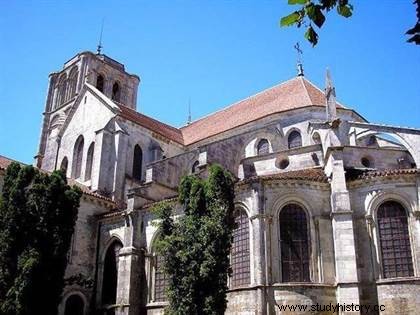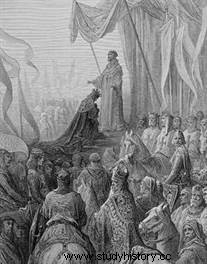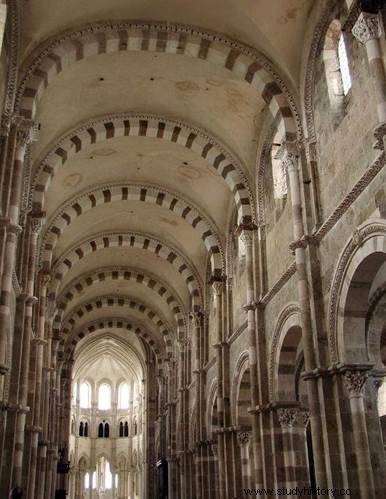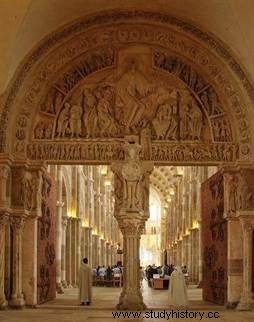 High place of history and medieval Christianity, classified as World Heritage by UNESCO, the abbey and basilica Sainte Marie Madeleine de Vézelay stands out today as a masterpiece of Romanesque architecture and an essential site in the Yonne department (Burgundy). Unmissable, the abbey church of Vézelay was from the XI
th
century by becoming a renowned place of pilgrimage throughout the medieval West thanks to the relics of Mary Magdalene.
High place of history and medieval Christianity, classified as World Heritage by UNESCO, the abbey and basilica Sainte Marie Madeleine de Vézelay stands out today as a masterpiece of Romanesque architecture and an essential site in the Yonne department (Burgundy). Unmissable, the abbey church of Vézelay was from the XI
th
century by becoming a renowned place of pilgrimage throughout the medieval West thanks to the relics of Mary Magdalene.
Vezelay Abbey, a major place of pilgrimage
The origin of its foundation comes from Count Girard de Roussillon when, at the instigation of his wife Berthe, he entrusted to nuns the relics brought back from Provence of Saint Madeleine. A village then formed in the plain around the Saint-Père-sous-Vézelay monastery. However, faced with the Norman invasions, the monastery, looted in 873, was transferred for more security to the hill of Vézelay while Benedictine monks replaced the nuns. A Carolingian church – whose crypt is still visible today – was consecrated in 878 while little by little, a pilgrimage developed around the relics of the saint.
 Thus attracting ever more numerous pilgrims, the abbey had to undergo enlargements, especially in the XI
and
in the XIII
th
centuries when it obtained from a papal bull its placement under the voice of Madeleine in 1050. But the basilica of Vézelay is also an essential stage on the road leading to Saint Jacques de Compostela allowing the small hamlet around the building to grow into a city of increasing renown until it becomes the starting point of a crusade.
Thus attracting ever more numerous pilgrims, the abbey had to undergo enlargements, especially in the XI
and
in the XIII
th
centuries when it obtained from a papal bull its placement under the voice of Madeleine in 1050. But the basilica of Vézelay is also an essential stage on the road leading to Saint Jacques de Compostela allowing the small hamlet around the building to grow into a city of increasing renown until it becomes the starting point of a crusade.
On March 31, 1146, at the foot of the hill of Vézelay, in the presence of an immense crowd and the King of France Louis VII, Bernard of Clairvaux known as Saint Bernard preached the second crusade. Less than fifty years later, the kings of France and England Philippe Auguste and Richard Coeur de Lion met there on the way to the third crusade.
The basilica of Vezelay, a masterpiece of Romanesque art
Having undergone enlargements and destruction during the Middle Ages, the basilica displays elements of both Gothic and Romanesque art. However, it is above all for the latter that it constitutes a formidable testimony to medieval architecture. As for the facade, we owe it to the restoration of Viollet-le-Duc in the 19 th century which saved the building from ruin. Indeed, from the 15th th century, the pilgrimage lost its importance and the activity of the abbey declined rapidly until it was abandoned during the French Revolution.
 The basilica consists of a Romanesque nave from the 12th
th
century replacing the Carolingian one destroyed by fire while the choir and transept are in the Gothic style of the 13
th
century. However, the visitor will be struck above all by the front nave often wrongly qualified as narthex and its three portals richly decorated with sculptures with very rich medieval symbolism. The basilica is one of the most important monuments of Romanesque Burgundy for its sculptural heritage. The decorations of the capitals and the aisles of the nave complete this symbolism by most often recounting scenes from the Old Testament, but not only. The capitals representing the Mystical Mill and the Fall of Simon the Magician are considered masterpieces of Romanesque sculpture.
The basilica consists of a Romanesque nave from the 12th
th
century replacing the Carolingian one destroyed by fire while the choir and transept are in the Gothic style of the 13
th
century. However, the visitor will be struck above all by the front nave often wrongly qualified as narthex and its three portals richly decorated with sculptures with very rich medieval symbolism. The basilica is one of the most important monuments of Romanesque Burgundy for its sculptural heritage. The decorations of the capitals and the aisles of the nave complete this symbolism by most often recounting scenes from the Old Testament, but not only. The capitals representing the Mystical Mill and the Fall of Simon the Magician are considered masterpieces of Romanesque sculpture.
This sculpture, presented as typical of the art of Romanesque Burgundy, is particularly similar to that of the Saint Lazare cathedral in Autun. However, there are many other points in common with other buildings in the region such as Saint Philibert de Tournus. The Gothic rib-vaulted choir is inspired by Sens Cathedral.
The village of Vézelay
Vézelay is not only its basilica, it is also a charming little village of barely 500 inhabitants classified among the "most beautiful villages in France". Perched on its hill overlooking the green valley of the Cure and the wild valleys of the Morvan – you can admire the panorama from the vast terrace located at the back of the basilica – Vézelay has a rich cultural and artistic heritage. Let us mention in particular the Museum of the Work Viollet-le-Duc returning to the restoration of the basilica or the Maison Jules Roy which has now become a house of writers while exposing the life of the author of La vallée happy .
 But above all, in the former house of Romain Rolland is now the Zervos museum, a small museum of 'Modern art really not to be missed for art lovers. The museum houses part of the collection bequeathed by Christian Zervos, art critic and publisher, founder of the magazine Les Cahiers d'art . And what a collection:works from the years 1925 to 1960 by Picasso, Giacometti, Ernst, Kandinsky and many others are exhibited here with a rare and effective simplicity.
But above all, in the former house of Romain Rolland is now the Zervos museum, a small museum of 'Modern art really not to be missed for art lovers. The museum houses part of the collection bequeathed by Christian Zervos, art critic and publisher, founder of the magazine Les Cahiers d'art . And what a collection:works from the years 1925 to 1960 by Picasso, Giacometti, Ernst, Kandinsky and many others are exhibited here with a rare and effective simplicity.
In short, Vézelay does not simply sum up its splendid basilica but also its charming little village which has managed to retain a certain authenticity despite the high tourist influx during the summer season.
To go further
- Vézelay - A path of light. Place wins, 2018.
- Vézelay and Saint Bernard, by Jacques d'Arès. Dervy, 2002.
